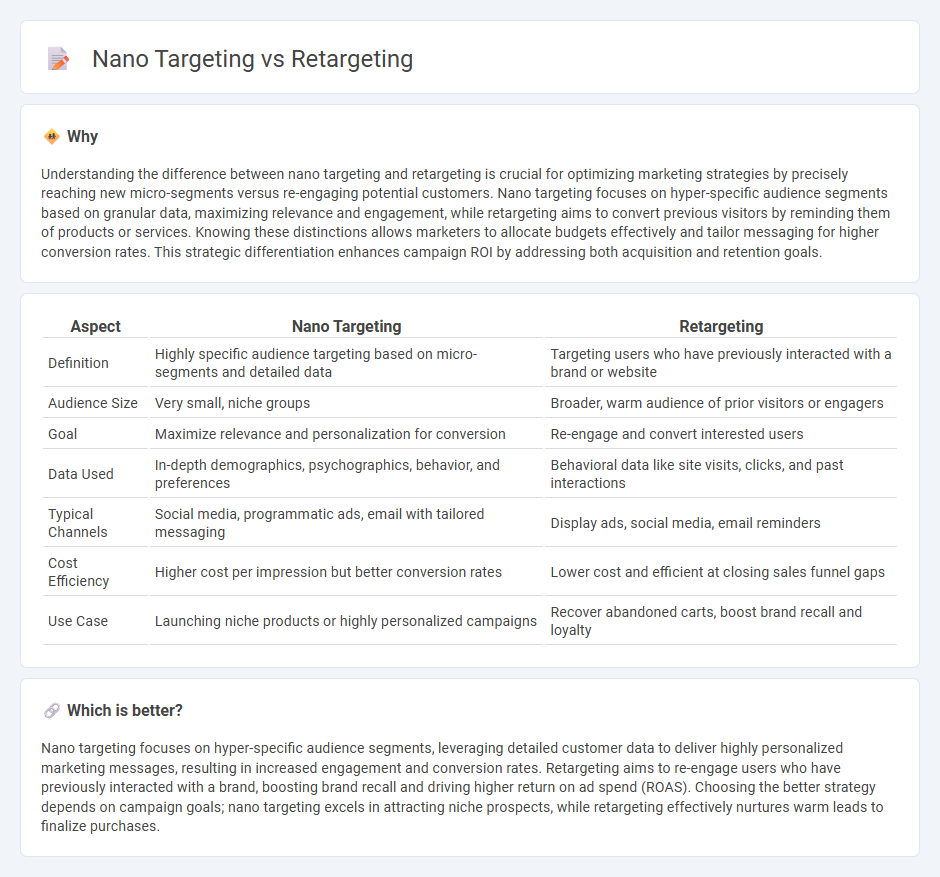
Nano targeting focuses on reaching extremely specific audience segments by leveraging granular data points such as individual behaviors, interests, and demographics, enabling highly personalized marketing campaigns. Retargeting involves re-engaging users who have previously interacted with a brand, using cookies or tracking pixels to deliver tailored ads that encourage return visits and conversions. Explore the key differences and benefits of nano targeting versus retargeting to optimize your marketing strategy.
Why it is important
Understanding the difference between nano targeting and retargeting is crucial for optimizing marketing strategies by precisely reaching new micro-segments versus re-engaging potential customers. Nano targeting focuses on hyper-specific audience segments based on granular data, maximizing relevance and engagement, while retargeting aims to convert previous visitors by reminding them of products or services. Knowing these distinctions allows marketers to allocate budgets effectively and tailor messaging for higher conversion rates. This strategic differentiation enhances campaign ROI by addressing both acquisition and retention goals.
Comparison Table
| Aspect | Nano Targeting | Retargeting |
|---|---|---|
| Definition | Highly specific audience targeting based on micro-segments and detailed data | Targeting users who have previously interacted with a brand or website |
| Audience Size | Very small, niche groups | Broader, warm audience of prior visitors or engagers |
| Goal | Maximize relevance and personalization for conversion | Re-engage and convert interested users |
| Data Used | In-depth demographics, psychographics, behavior, and preferences | Behavioral data like site visits, clicks, and past interactions |
| Typical Channels | Social media, programmatic ads, email with tailored messaging | Display ads, social media, email reminders |
| Cost Efficiency | Higher cost per impression but better conversion rates | Lower cost and efficient at closing sales funnel gaps |
| Use Case | Launching niche products or highly personalized campaigns | Recover abandoned carts, boost brand recall and loyalty |
Which is better?
Nano targeting focuses on hyper-specific audience segments, leveraging detailed customer data to deliver highly personalized marketing messages, resulting in increased engagement and conversion rates. Retargeting aims to re-engage users who have previously interacted with a brand, boosting brand recall and driving higher return on ad spend (ROAS). Choosing the better strategy depends on campaign goals; nano targeting excels in attracting niche prospects, while retargeting effectively nurtures warm leads to finalize purchases.
Connection
Nano targeting leverages hyper-specific audience data to deliver personalized marketing messages to niche segments, maximizing relevance and engagement. Retargeting complements nano targeting by focusing on users who have previously interacted with content or products, reinforcing brand presence and encouraging conversion. Together, these strategies optimize customer acquisition and retention through precise, data-driven ad placements.
Key Terms
Audience Segmentation
Retargeting focuses on re-engaging users who have already interacted with a brand by segmenting audiences based on previous behavior such as website visits or cart abandonment, leveraging cookies and pixel tracking for personalized ads. Nano targeting, on the other hand, takes audience segmentation to a granular level, using hyper-specific demographic, psychographic, and contextual data to tailor messages for ultra-niche groups, often with the aid of AI-driven analytics. Explore the key differences and strategic benefits of retargeting versus nano targeting to enhance your marketing campaigns.
Ad Personalization
Retargeting targets users who have already interacted with a brand, using personalized ads based on previous behavior to increase conversion rates, while nano targeting focuses on hyper-specific audience segments by leveraging detailed demographic, psychographic, and behavioral data for highly customized ad experiences. Both strategies drive ad personalization but nano targeting offers deeper precision, ideal for niche markets and maximizing relevancy in ad delivery. Explore how blending retargeting and nano targeting can elevate your marketing effectiveness.
Conversion Optimization
Retargeting targets users who have previously interacted with a brand, leveraging behavioral data to increase conversion rates by reminding potential customers of products or services. Nano targeting, a hyper-granular approach, customizes ads to extremely specific audience segments based on detailed demographics and interests, leading to higher relevance and engagement in conversion optimization campaigns. Discover how integrating these strategies can maximize your advertising ROI and drive more effective conversions.
Source and External Links
What Is Retargeting? How To Set Up an Ad - This webpage provides a beginner's guide to retargeting, explaining how it works and its benefits in digital marketing.
Retargeting: Definition, Types and How-tos - This article defines retargeting, explains its types, and offers practical advice on how to implement it effectively.
Retargeting | Digital Advertising Glossary - This digital advertising glossary entry explains what retargeting is and discusses common campaign types such as site retargeting and search retargeting.
 dowidth.com
dowidth.com